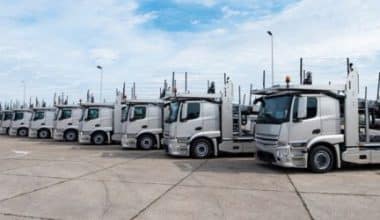The term “inland marine” should not be misconstrued. Unlike “marine insurance,” which provides coverage for goods during transportation over water, inland marine insurance provides coverage for goods, materials, and equipment during transportation over land, such as truck, train, or third-party storage Collisions and cargo theft are the primary causes of losses in inland marine insurance. This article focuses on Inland Marine Insurance coverage, its cost, and the company.
Inland Marine Insurance
Inland marine insurance provides coverage for potential loss or damage incurred by businesses in relation to the transportation of equipment, machinery, products, or other property over land. This includes assets used inside a professional work environment, stored within a designated facility, or transported via rail or road. Inland marine insurance is a distinct kind of insurance that is derived from ocean marine insurance and is primarily designed to provide coverage for property that is being carried on land.
Does Your Business Need Inland Marine Insurance?
It’s possible that a Business Owners Policy (BOP) or Commercial Package Policy (CPP)’s coverage for your company’s property will be more than enough. In general, this sort of insurance covers property that is held at a single place, but tools and equipment that employees bring to adjacent job sites may also be covered.
If your company routinely ships products or equipment, you should consider obtaining inland marine insurance. This type of coverage is especially crucial if you send high-value items or materials that are frequently excluded from standard property coverage. Inland marine insurance can protect a variety of specialized equipment and items, such as:
- Servers, computers, and every other kind of computer.
- Communication and networking equipment.
- Construction and contracting equipment.
- Medical and scientific equipment.
- Photographic equipment.
Special Types of Inland Marine Insurance
There are various types of inland marine insurance; each coverage aims at a certain type of property. Here are a couple of such instances.
- Contractor’s Equipment Floater: Covers loss, damage, or theft of a contractor’s equipment or tools wherever the loss happens, including the contractor’s office, a job site, or in transportation.
- EDP Insurance: protects firms against the loss or destruction of desktop computers, mainframes, laptops, tablets, and other data processing or storage equipment. Policies cover damage resulting from a variety of risks, including fire, floods, theft, and electrical disruptions.ners, computer repair services, and pet boarding operators are examples of businesses that require this coverage.
- Accounts Receivable Insurance: protects your company against financial losses caused by a covered risk damaging or destroying your accounts receivable records or your customers failing to pay invoices.
- Installation Floater: Protects contractors against the theft, damage, or destruction of equipment, materials, or supplies while in transit or awaiting installation at a construction site due to a covered peril.
Read Also: Small Business Liability Insurance: How Does It Work?
Inland Marine Insurance Coverage
Generally speaking, inland marine insurance comprises the following coverages:
- Property in Transit: This is a property that is transported from one location to another over land.
- Off-Site Property: This includes items maintained in a storage facility or warehouse.
- Property on Moving Vehicles: For example, inland marine coverage would include the cooking equipment and raw ingredients held in a food truck.
- Transportation-Related Property: Inland marine insurance can protect companies that own bridges, roads, and communication towers.
Custom coverage for specific properties is also available through inland marine insurance. Dealers and galleries, for example, must store work that belongs to others. Veterinarians may need to transfer live animals to a clinic. A vending machine owner may leave their machine on someone else’s property for a long time. In all of these cases, inland marine insurance can provide coverage.
The name of your inland marine insurance may vary depending on the risks you’re insuring against and the sort of business you have. For example, inland marine insurance is referred to as “bailee’s customer insurance” when conveying a client’s property. Builder’s risk insurance protects the tools and machinery used on construction sites and in storage yards.
How Much Inland Marine Insurance Coverage Do You Need?
Many small-business owners are unsure of how much inland marine insurance they require. You can’t always anticipate the extent of a future loss with 100% accuracy. However, you might begin by determining the worth of your covered property.
For example, if you’re a contractor and you leave 20 pieces of equipment worth $20,000 apiece in a storage yard, you’d want inland marine coverage to cover you up to $200,000. However, if just five pieces of equipment are stored at any given time, you may only require half the amount of inland marine coverage.
What Is Not Covered by Inland Marine Insurance?
Typically, inland marine insurance excludes:
- Stationary property: Ordinary commercial property insurance will cover this.
- To cover the vehicles you use for business purposes, you must purchase commercial auto insurance. Inland marine insurance, on the other hand, can safeguard the contents of your vehicle.
- Damage caused by earthquakes and floods: Companies located in high-risk areas should invest in either commercial flood insurance or commercial earthquake insurance.
- Property moved by sea or air requires ocean marine insurance or air cargo insurance, accordingly.
- Property damaged prior to shipment: Typically, inland maritime insurance only covers damage or loss that happens during transit.
The cost of your company’s property is one aspect among many that affect the price of inland marine insurance. This policy costs $29 per month, on average, for small businesses.
Read Also: Cheap Business Insurance Providers 2023
Inland Marine Insurance Cost
The average cost of inland marine insurance for a small business is $29 per month or $350 per year. This is the average premium paid by clients for coverage with the industry’s top insurers. Because it eliminates extremely high and low rates, the median provides a more accurate estimate of what your company may expect to pay.
Understanding the Cost Factors of Inland Marine Insurance
How does the inland marine insurance type impact costs? Different types of property may necessitate different types of insurance coverage. plans tailored to cover less expensive objects will be less expensive than plans designed to protect precious items. The following are the most prevalent kinds of inland marine insurance:
- Contractor’s tools and equipment insurance, also known as equipment floater insurance, is intended to safeguard newer contractor’s tools and equipment worth less than $10,000. This coverage is frequently relatively economical because it protects lower-value products.
- Bailee’s customer coverage is recommended for organizations that handle customer property in the event that the things are damaged while in your care, custody, or control.
- Installation floater insurance protects building materials and other moveable property while they are being installed or built on a construction site. This could be a heating and cooling system or roofing materials.
- Builder’s risk insurance is a more inclusive policy that covers damages incurred during construction. It would, for example, cover expenditures if a fire damaged a structure in progress or building supplies on a construction site.
- Cargo insurance for motor trucks shields the goods or items from liability. Trucking companies frequently use this coverage to safeguard client cargo while it is in transit.
How Do Policy Limits Affect the Cost of Inland Marine Insurance?
The value of the assets you want to insure largely determines the cost of inland marine insurance, just like commercial property insurance. For example, high-value commodities such as fine art, motor vehicle freight, bulldozers, and forklifts will cost more to insure.
The coverage limits on your policy should be sufficient to cover a potential claim, whether it’s a fire in a food truck’s kitchen or a camera dropped by a photographer at a wedding. Higher coverage limits are more expensive, but they cover larger losses.
Keep in mind that your deductible has an impact on the cost of your insurance. A higher deductible lowers your premium, but you must pay that amount before the insurance insurer will cover a claim.
How Does Your Industry Impact the Cost of Inland Marine Insurance?
Professionals who use pricey equipment choose higher limitations and pay more to be safe. Because your occupation dictates the type of property you require, you may estimate how much you’ll pay for insurance based on your industry.
Landscapers, installation professionals, and contractors, for example, must often ensure tools and other equipment are transported to job sites. They frequently purchase contractors’ tools and equipment insurance, which is a low-cost policy.
Technology companies and distributors, on the other hand, might expect to spend more on inland marine insurance. This is most likely due to the high cost of insuring expensive devices and transporting valuable items.
Read Also: Business Insurance for Consultants: What It Is & How Much It Costs
Inland Marine Insurance Company
The following includes the inland marine company:
#1. The Hartford
Modern inland marine insurance is a broad category that includes a wide range of policies, and Hartford covers nearly all of them. The company categorizes its inland marine insurance into five sections: construction, technology, transportation, equipment, and miscellaneous inland marine, which covers everything from collectibles to vending machines.
Within each category, you’ll discover extremely precise policies aimed at specific sectors. Renewable energy enterprises, vending machine operators, and art and entertainment companies, to mention a few, all have their own inland maritime insurance with Hartford.
Hartford, a well-known business insurance provider, provides its clients with 24-hour customer support and simple online claims. In the 2022 J.D. Power U.S. Small Commercial Insurance Study, the inland marine insurance company did not do well. However, AM Best has given it a strong A+ grade.
#2. Great American Insurance Group
Bailee’s customers’ insurance, often known as bailee insurance, is a critical type of inland marine insurance for any company that takes temporary control of customers’ property. Dry cleaners, valets, storage units, and electronics repair services are a few examples. This form of protection shields you from financial liability if a customer’s things are damaged or stolen while in your care, a liability that your business property insurance policy does not cover.
While many commercial insurers provide bailee insurance as an add-on to other policies, Great American Insurance Group stands out by providing both solo and combination coverage. The supplier provides two types of Bailee insurance: Bailee’s legal liability coverage for B2B enterprises and Bailee’s customer coverage for businesses that provide retail services.
#3. Chubb
We all know that the term “contractor” refers to a broad category that includes general contractors, tradespeople, large construction businesses, and everyone in between. However, every one of them can benefit from inland marine insurance, which they can all find through Chubb.
In truth, Chubb began in the late 18th century as a provider of marine insurance coverage and has since grown to become the world’s largest publicly traded property and casualty insurance firm. Chubb’s inland maritime policies address a wide range of contractor requirements. Builder’s risk insurance, which is designed to safeguard structures while they are being built or rebuilt, is offered for both residential and commercial contractors, as well as small single-location builders. A supplemental policy covering owned equipment, leased equipment, and employees’ personal tools is offered for contractors’ tools.
What Does Marine Insurance Cover?
Ships, cargo, terminals, transports, and transfers are all covered by marine insurance. If your boat or other watercraft experiences damage or stolen, marine insurance will pay to fix it or replace it.
Why Is Marine Insurance Called Marine?
The word was first used when traders began sending their wares across the ocean. Marine insurance covers not just shipping via sea but also air, rail, and road. A contract for marine cargo insurance is one type of insurance used while transporting products by air.
What Is Marine Insurance Called?
The cost of marine insurance is typically shared between the boats and the cargo. “Hull and Machinery” (H&M) insurance is what most ship owners opt for when purchasing ship insurance. “Total Loss Only” (TLO) coverage is less comprehensive and typically serves as backup insurance. It only pays out if the whole ship is lost.
What Are the Principles of Marine Insurance?
The Marine Insurance Act of 1963 lays out the basic rules for marine insurance, which are the same as those for property insurance. These rules include indemnity, insurable interest, greatest good faith, proximate cause, subrogation, and contribution.
Who Is the Largest Marine Insurer?
When it comes to marine insurance, Allianz Commercial is a major player on a global scale. The unrivaled depth and breadth of capabilities give us an edge in the market and make us experts in our field.






